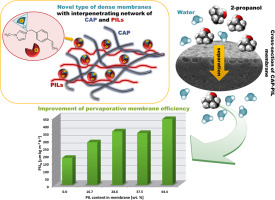当前位置:
X-MOL 学术
›
J. Membr. Sci.
›
论文详情
Our official English website, www.x-mol.net, welcomes your
feedback! (Note: you will need to create a separate account there.)
Physicochemical Properties and Pervaporation Performance of Dense Membranes Based on Cellulose Acetate Propionate (CAP) and Containing Polymerizable Ionic Liquid (PIL)
Journal of Membrane Science ( IF 8.4 ) Pub Date : 2017-12-01 , DOI: 10.1016/j.memsci.2017.09.031 Edyta Rynkowska , Krzysztof Dzieszkowski , Antoine Lancien , Kateryna Fatyeyeva , Anthony Szymczyk , Joanna Kujawa , Stanisław Koter , Stéphane Marais , Andrzej Wolan , Wojciech Kujawski
Journal of Membrane Science ( IF 8.4 ) Pub Date : 2017-12-01 , DOI: 10.1016/j.memsci.2017.09.031 Edyta Rynkowska , Krzysztof Dzieszkowski , Antoine Lancien , Kateryna Fatyeyeva , Anthony Szymczyk , Joanna Kujawa , Stanisław Koter , Stéphane Marais , Andrzej Wolan , Wojciech Kujawski

|
Abstract The new type of efficient pervaporative separation hybrid materials based on cellulose acetate propionate (CAP) and doped with 1-methyl-3-(4-vinylbenzyl)-1H-imidazol-3-ium chloride polymerizable ionic liquid (PIL) monomers (12.3–44.4 wt%) were elaborated for dehydration of propan-2-ol. Broad material and physicochemical characterization of membranes was performed including assessment of physicochemical, equilibrium, transport, and separation properties. Incorporation of PIL results in the plasticization of CAP based membranes. Additionally, with increasing loading of PIL from 12.3 to 44.4 wt% values of thickness-normalized Pervaporation Separation Index (PSI N ) increase 1.6–2.4 times comparing to unloaded membrane (pure CAP). The distance parameters calculated on the base of the Hansen's solubility parameters were additionally employed to interpret swelling and pervaporative properties of membranes as well as to discuss interactions between solvents and prepared membranes. Lower value of distance parameter between pristine CAP and ethanol corresponds to the highest molar swelling degree of CAP based membranes. Swelling of CAP-PIL membranes in contact with water, ethanol, and propan-2-ol increased with of the increasing PIL content due to the hydrophilic character of ionic liquid. The gathered data provided insight into the potential applicability of the novel hybrid separation materials for pervaporative separation of liquid-liquid mixtures.
中文翻译:

基于醋酸丙酸纤维素 (CAP) 并含有可聚合离子液体 (PIL) 的致密膜的理化性质和渗透蒸发性能
摘要 基于醋酸丙酸纤维素 (CAP) 并掺杂 1-甲基-3-(4-乙烯基苄基)-1H-咪唑-3-氯化鎓可聚合离子液体 (PIL) 单体 (12.3 –44.4 wt%) 用于丙-2-醇的脱水。对膜进行了广泛的材料和物理化学表征,包括物理化学、平衡、传输和分离特性的评估。PIL 的掺入导致基于 CAP 的膜的塑化。此外,随着 PIL 的负载量从 12.3 重量%增加到 44.4 重量%,与无负载膜(纯 CAP)相比,厚度标准化渗透蒸发分离指数 (PSI N) 增加了 1.6-2.4 倍。基于 Hansen' 计算的距离参数 溶解度参数还用于解释膜的溶胀和渗透蒸发特性,以及讨论溶剂和制备的膜之间的相互作用。原始 CAP 和乙醇之间距离参数的较低值对应于基于 CAP 的膜的最高摩尔溶胀度。由于离子液体的亲水特性,CAP-PIL 膜与水、乙醇和丙二醇接触时的溶胀随着 PIL 含量的增加而增加。收集的数据提供了对新型混合分离材料在液-液混合物渗透蒸发分离中的潜在适用性的洞察。原始 CAP 和乙醇之间距离参数的较低值对应于基于 CAP 的膜的最高摩尔溶胀度。由于离子液体的亲水特性,CAP-PIL 膜与水、乙醇和丙二醇接触时的溶胀随着 PIL 含量的增加而增加。收集的数据提供了对新型混合分离材料在液-液混合物渗透蒸发分离中的潜在适用性的洞察。原始 CAP 和乙醇之间距离参数的较低值对应于基于 CAP 的膜的最高摩尔溶胀度。由于离子液体的亲水特性,CAP-PIL 膜与水、乙醇和丙二醇接触时的溶胀随着 PIL 含量的增加而增加。收集的数据提供了对新型混合分离材料在液-液混合物渗透蒸发分离中的潜在适用性的洞察。
更新日期:2017-12-01
中文翻译:

基于醋酸丙酸纤维素 (CAP) 并含有可聚合离子液体 (PIL) 的致密膜的理化性质和渗透蒸发性能
摘要 基于醋酸丙酸纤维素 (CAP) 并掺杂 1-甲基-3-(4-乙烯基苄基)-1H-咪唑-3-氯化鎓可聚合离子液体 (PIL) 单体 (12.3 –44.4 wt%) 用于丙-2-醇的脱水。对膜进行了广泛的材料和物理化学表征,包括物理化学、平衡、传输和分离特性的评估。PIL 的掺入导致基于 CAP 的膜的塑化。此外,随着 PIL 的负载量从 12.3 重量%增加到 44.4 重量%,与无负载膜(纯 CAP)相比,厚度标准化渗透蒸发分离指数 (PSI N) 增加了 1.6-2.4 倍。基于 Hansen' 计算的距离参数 溶解度参数还用于解释膜的溶胀和渗透蒸发特性,以及讨论溶剂和制备的膜之间的相互作用。原始 CAP 和乙醇之间距离参数的较低值对应于基于 CAP 的膜的最高摩尔溶胀度。由于离子液体的亲水特性,CAP-PIL 膜与水、乙醇和丙二醇接触时的溶胀随着 PIL 含量的增加而增加。收集的数据提供了对新型混合分离材料在液-液混合物渗透蒸发分离中的潜在适用性的洞察。原始 CAP 和乙醇之间距离参数的较低值对应于基于 CAP 的膜的最高摩尔溶胀度。由于离子液体的亲水特性,CAP-PIL 膜与水、乙醇和丙二醇接触时的溶胀随着 PIL 含量的增加而增加。收集的数据提供了对新型混合分离材料在液-液混合物渗透蒸发分离中的潜在适用性的洞察。原始 CAP 和乙醇之间距离参数的较低值对应于基于 CAP 的膜的最高摩尔溶胀度。由于离子液体的亲水特性,CAP-PIL 膜与水、乙醇和丙二醇接触时的溶胀随着 PIL 含量的增加而增加。收集的数据提供了对新型混合分离材料在液-液混合物渗透蒸发分离中的潜在适用性的洞察。











































 京公网安备 11010802027423号
京公网安备 11010802027423号